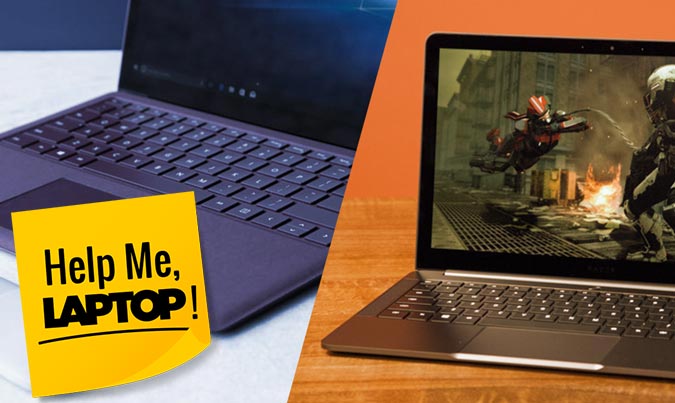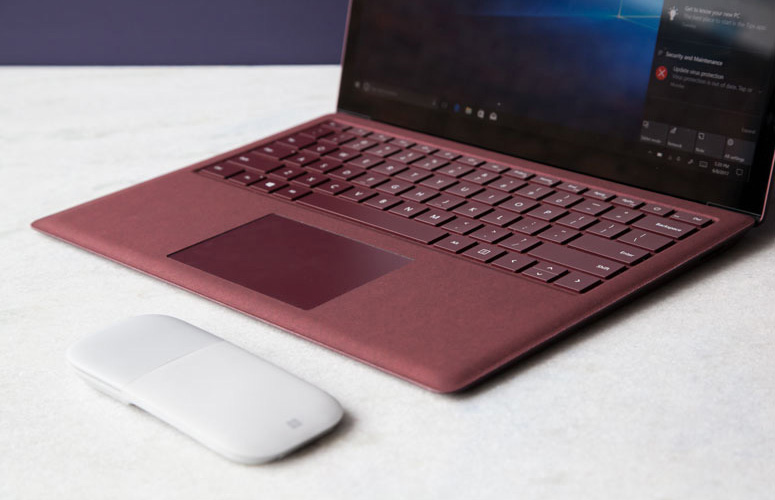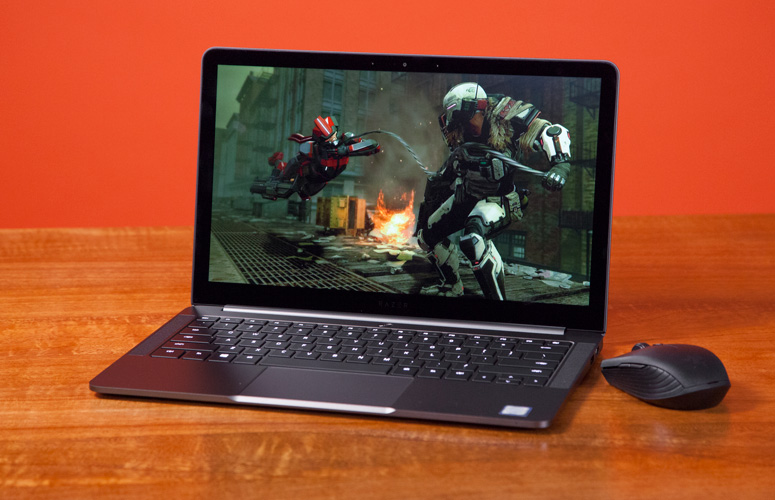Help Me, Laptop: Razer Blade Stealth or Microsoft Surface Laptop?
Ah, spring — when a young person's thoughts turn to ... college. Forum member trioxlight is scouting out laptops for college next year and is looking for a notebook that can handle photo and video editing.

Currently, trioxlight owns a Microsoft Surface Laptop (starting at $699.99) but is worried about how it will hold up when editing video using Vegas and Adobe Premiere, due to the laptop's dual-core processor. So now they're looking at investing in the 13-inch Razer Blade Stealth (starting at $1,199.99).
However, trioxlight has questions about the display quality, particularly in regard to content adaptive backlight control (CABC), which automatically adjusts the brightness of the display's backlighting in an effort to boost image detail and preserve battery life.
We took a look at both laptops to see which is best for trioxlight's needs. But before we get started, here are the specs for each system.
| Row 0 - Cell 0 | Microsoft Surface Laptop | Razer Blade Stealth (13 inch) |
| CPU | 2.7-GHz Intel Core i5-7200U | 1.8-GHz Intel Core i7-8550U |
| GPU | Intel Iris Plus Graphics 640 | Intel HD Graphics 620 |
| RAM | 8GB | 16GB |
| Storage | 256GB SSD | 512GB PCIe m.2 SSD |
| Display | 13.5 inches, 2256 x 1504 pixels | 13.3 inches, 3200 x 1800 pixels |
| Dimensions | 2.8 pounds, 12.1 x 8.8 x 0.6 inches | 2.8 pounds, 12.6 x 8.1 x 0.5 inches |
Display
Razer knows how to make a pretty display, as evidenced by its 13.3-inch 3200 x 1800 touch panel. In our testing, the display reproduced 121 percent of the sRGB gamut and averaged 328 nits of brightness. The Surface Laptop's 13.5-inch, 2256 x 1504 touch display is both more colorful and brighter, with 135 percent and 361 nits, which definitely gives it an advantage.
Trioxlight is concerned about the CABC altering the backlighting and changing how an image looks. It wouldn't necessarily matter if you were just watching a movie, but considering they want to do photo and video editing, it's something to think about. Luckily, Razer has a firmware update tool to disable the feature.
Stay in the know with Laptop Mag
Get our in-depth reviews, helpful tips, great deals, and the biggest news stories delivered to your inbox.
MORE: The Best Laptops for Business and Productivity
According to our sister site Anandtech, the Surface Laptop also has CABC, but it's not as severe as other systems, affecting the brightness only by 20 to 30 nits. And while you can disable adaptive brightness on the system, there's no straightforward way to do the same for adaptive contrast. It's something trioxlight will have to take into account.
Winner: Microsoft Surface Laptop
Design
I'm a longtime fan of the Razer's laptop design. The obsidian CNC aluminum boasts premium construction and just looks flat-out sexy. And if black's not trioxlight's thing, they can get the laptop in an equally stunning gunmetal gray, although that means they lose out on that captivating Chroma keyboard with its individually lit RGB keys.
At 2.8 pounds and 12.6 x 8.1 x 0.5 inches, the Stealth is the lightest and slimmest laptop in the Blade family. As far as ports, the system has a USB 3.0 port and a full HDMI 2.0-out port on the right side, with another USB 3.0 port, Thunderbolt 3 port and headset jack on the left.

And whereas Razer goes for stately designs, Microsoft dares to play with color, offering the Surface Laptop in several colors, including burgundy, platinum, cobalt blue and graphite gold. Color, however, doesn't come cheap. With the exception of platinum, which you get for $699, you can get the other colors only if you're willing to fork over $1,299.99 to start.
Whatever color trioxlight chooses, they get to run their fingers over the luxurious Alcantara keyboard deck. The Surface Laptop weighs the same as the Stealth, but it's a little thicker, at 12.1 x 8.8 x 0.6 inches. We were disappointed to learn that the Surface Laptop has neither a USB Type-C port nor Thunderbolt 3. Instead, it has a full-size USB 3 port and a Mini DisplayPort with a proprietary connector that offers power, video and data and is compatible with the $199 Surface Dock in case you need more ports.
Winner: Microsoft Surface Laptop
Performance
Unfortunately, we didn't review the Core i7 configuration of the Surface Laptop (we evaluated the Core i5 model), so this won't be an apples-to-apples comparison. It should also be noted that Microsoft has yet to release a configuration of the Surface Laptop with an 8th Gen Intel processor.
When we ran our general performance test, Geekbench 4, the Surface Laptop's 2.7-GHz Intel Core i5-7200U processor scored 7,157, while the Stealth's 1.8-GHz Intel Core i7-8550U CPU hit 13,694, nearly lapping its competitor. During the productivity test, in which both systems paired 20,000 names and addresses, the Stealth completed the task in 3 minutes and 21 seconds, while the Surface Laptop finished in 4:01.
MORE: Which Laptop CPU is Right for You?
To test each laptop's SSD, we had them copy a 4.97GB multimedia file. The Surface Laptop (256GB SSD) delivered a transfer rate of 110.6 megabytes per second, and the Stealth (512GB PCIe M.2 SSD) had a blistering speed of 462.6 MBps.
While neither laptop will be playing Far Cry 5 anytime soon (unless you have an eGPU to use with the Stealth), both systems' integrated Intel HD Graphics 620 GPUs are powerful enough to handle light to moderate gaming and editing. The Stealth pumped out 53 frames per second during the Dirt 3 benchmark, while the Surface Laptop delivered 68 fps.
Winner: Razer Blade Stealth
Battery Life
The Surface Laptop certainly has staying power, lasting 9 hours and 2 minutes on our battery test. Despite the Stealth's power and good looks, Razer still hasn't figured out how to extend the laptop's subpar battery life. The notebook tapped out after only 5:21.
Winner: Microsoft Surface Laptop
Operating System
Instead of full-blown Windows 10, the Surface Laptop has Windows 10 S, a streamlined version of the Windows operating system. This stripped-down version of the OS only allows you to download apps only from the Windows Store, so that means no Google Chrome, Adobe Photoshop Premiere or a lot of other mainstream apps.

It also means that trioxlight has been relegated to using Edge as a browser and Bing as a search engine, which is less than ideal. However, those limitations ensure that system performance is faster and that the system is better protected against malware that can come from third-party apps.
The Stealth has a full version of Windows 10, which greatly expands the selection of apps. However, downloading apps and utilities from third-party sites can be a crapshoot and can introduce the laptop to all sorts of malware. Still, you can download Chrome, and you aren't confined to the Windows Store.
Winner: Razer Blade Stealth
Bottom Line
Ultimately, the Razer Blade Stealth offers more power in its sleek 13-inch frame than the Microsoft Surface Book, thanks to the former's 8th Gen Intel processor. The laptop also offers faster transfer speeds and the full Windows 10 experience. And although the Blade Stealth does have CABC, Razer has included a way for trioxlight to disable the feature. However, a rather subpar battery life is an albatross around the neck of an otherwise great laptop.
The Microsoft Surface Laptop comes in a variety of eye-catching colors and boasts a display that's brighter and more vivid than the Stealth's panel. But with that machine, trioxlight will have to be OK with not disabling the CABC or going through a bit of a hassle to do so. They'll also have to contend with a less powerful system with a slower SSD and Windows S, a restrictive version of the Windows 10 operating system. But the system does have the advantage of lasting over 9 hours on a charge.
But because trioxlight already owns the Surface Laptop, I wouldn't recommend shelling out $1,299 unless they require more power and access to better video editing tools.
Credit: Shaun Lucas/Laptop Mag

Sherri L. Smith has been cranking out product reviews for Laptopmag.com since 2011. In that time, she's reviewed more than her share of laptops, tablets, smartphones and everything in between. The resident gamer and audio junkie, Sherri was previously a managing editor for Black Web 2.0 and contributed to BET.Com and Popgadget.
